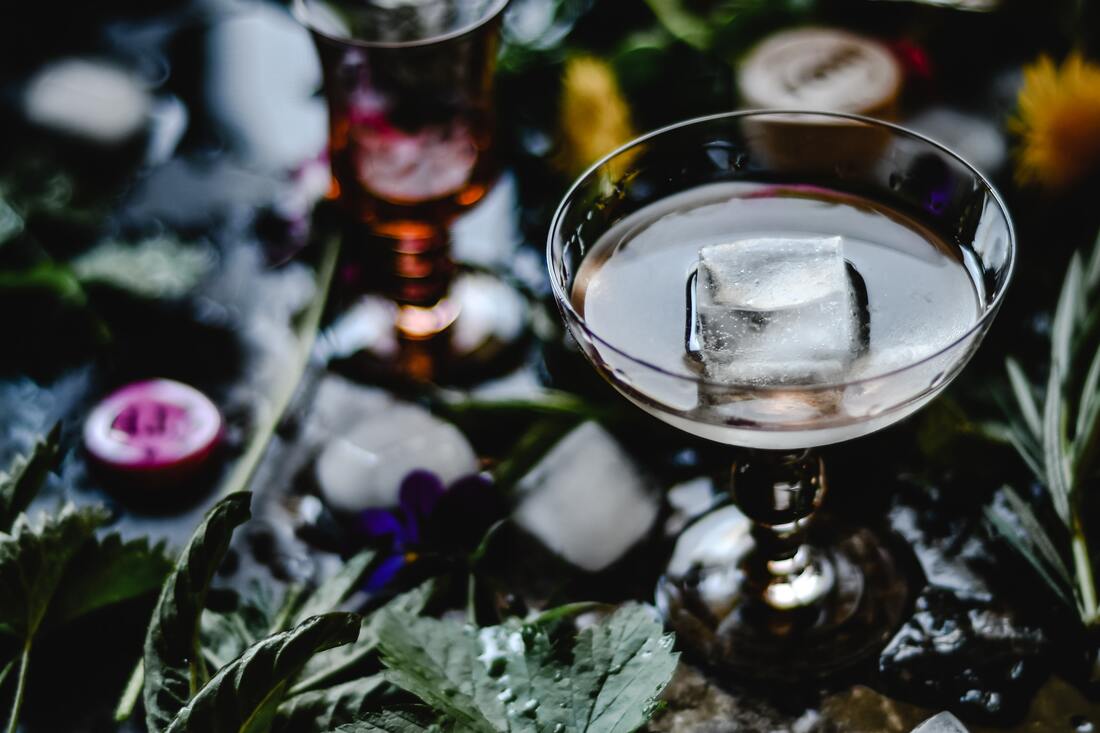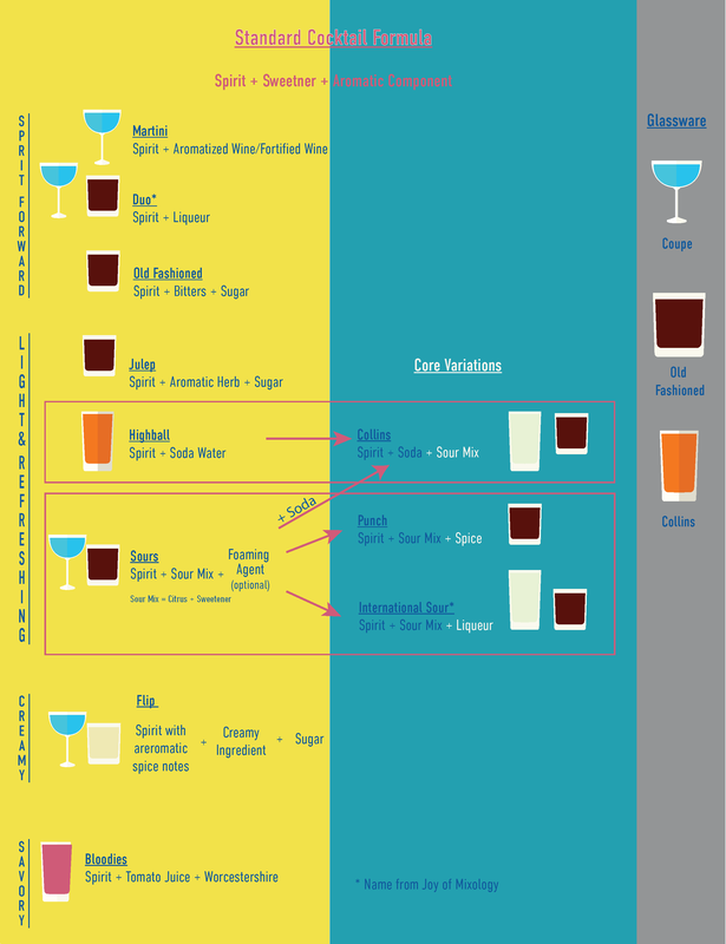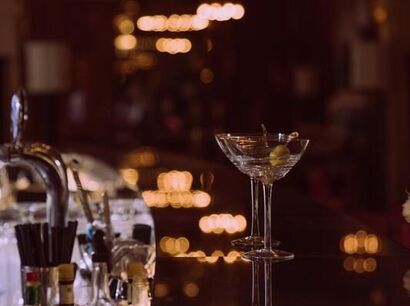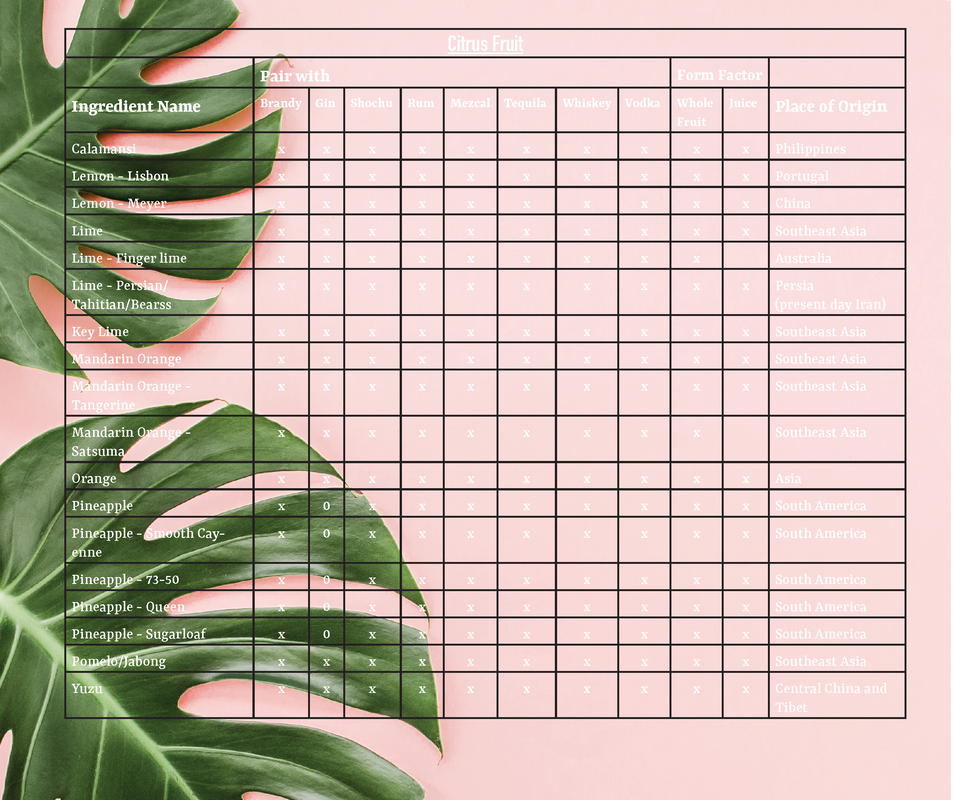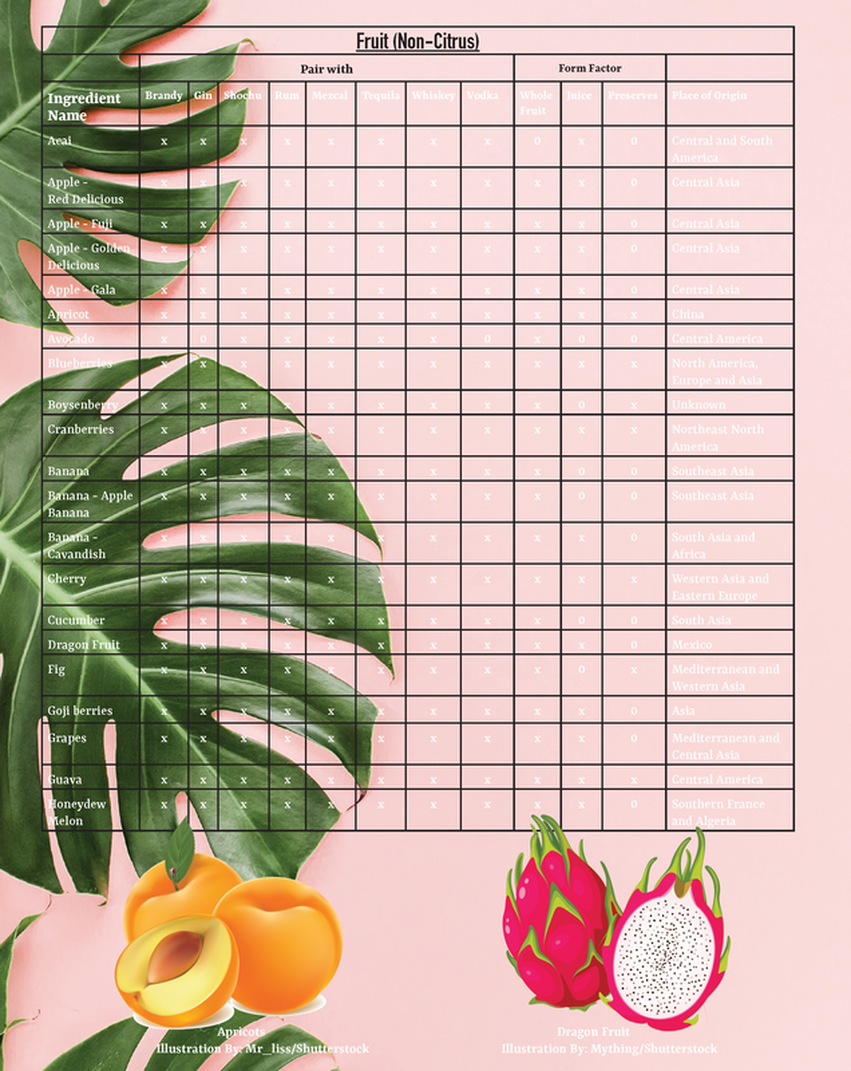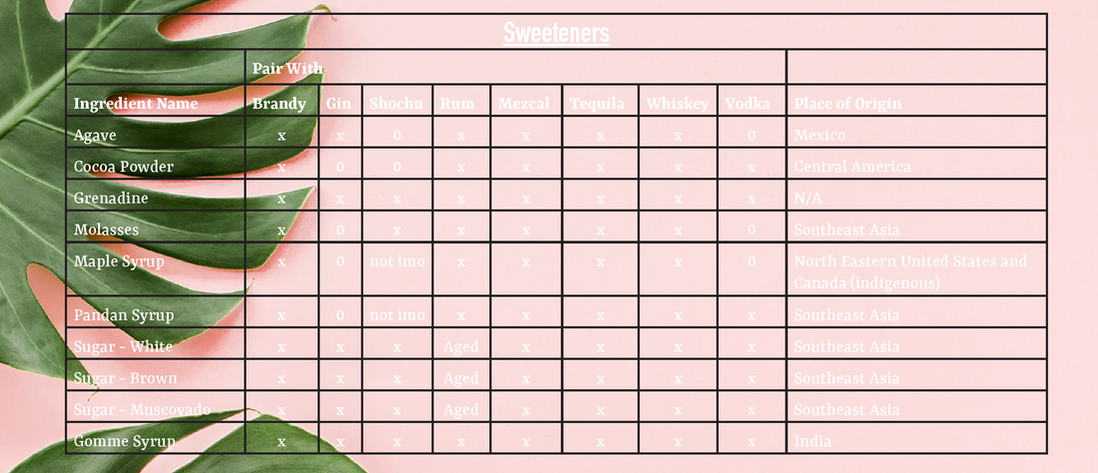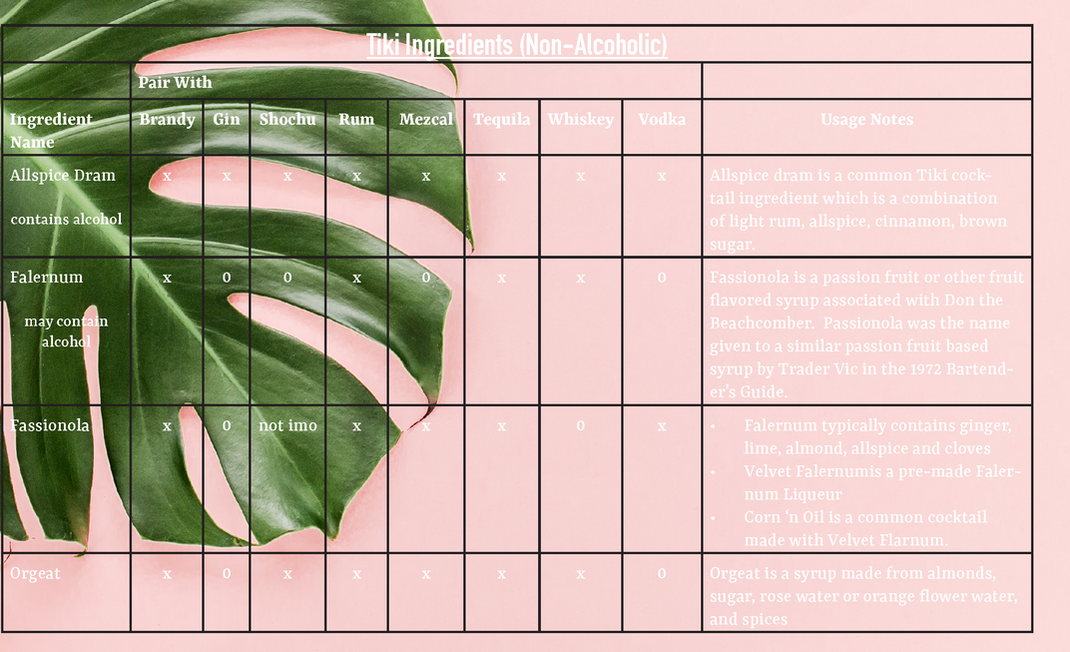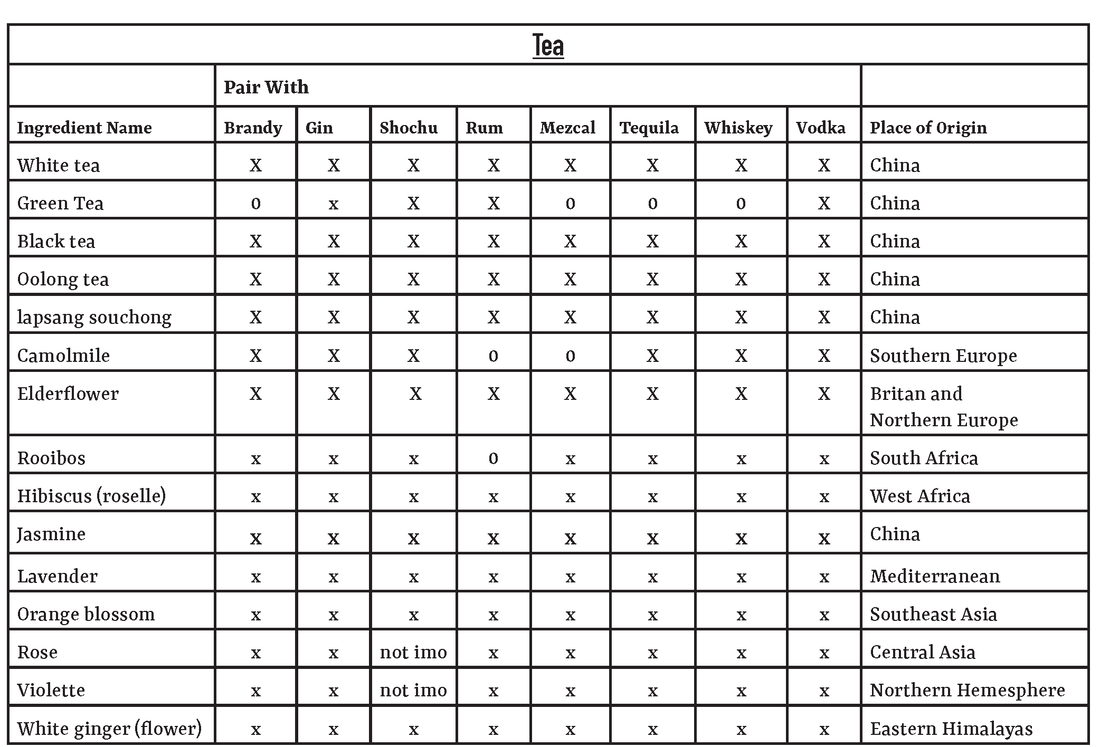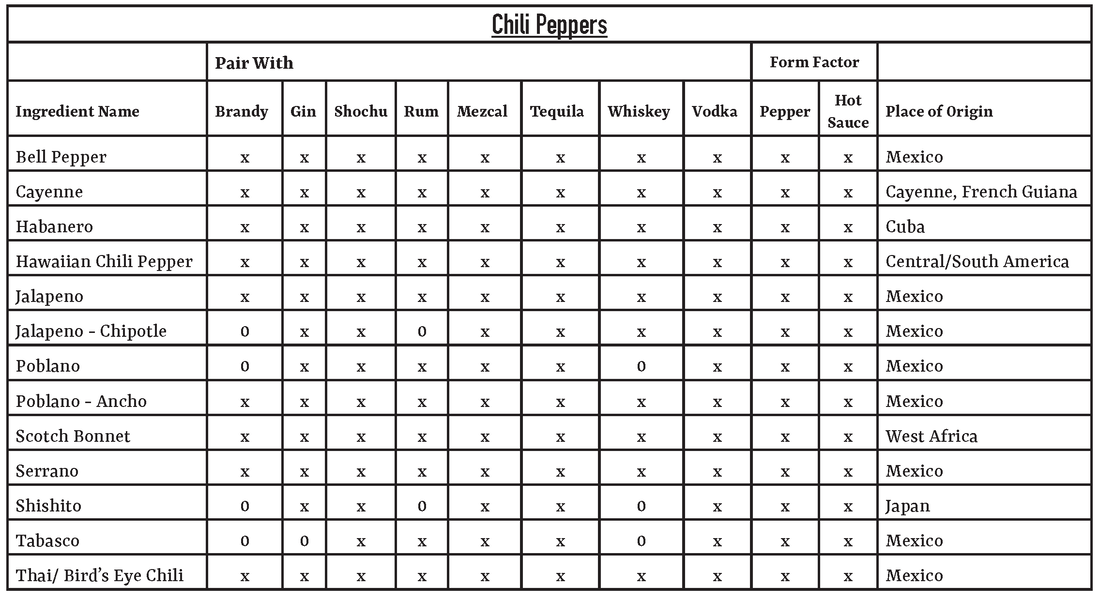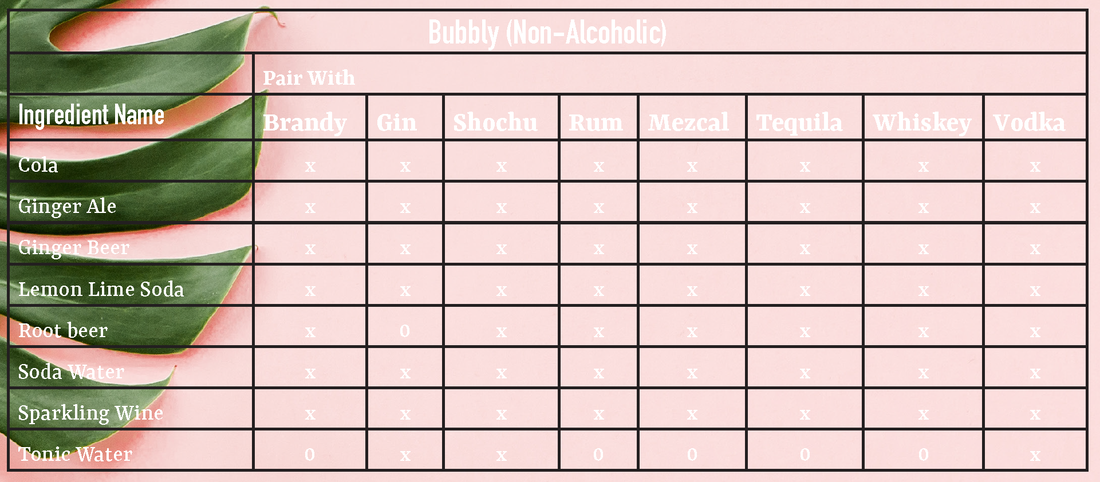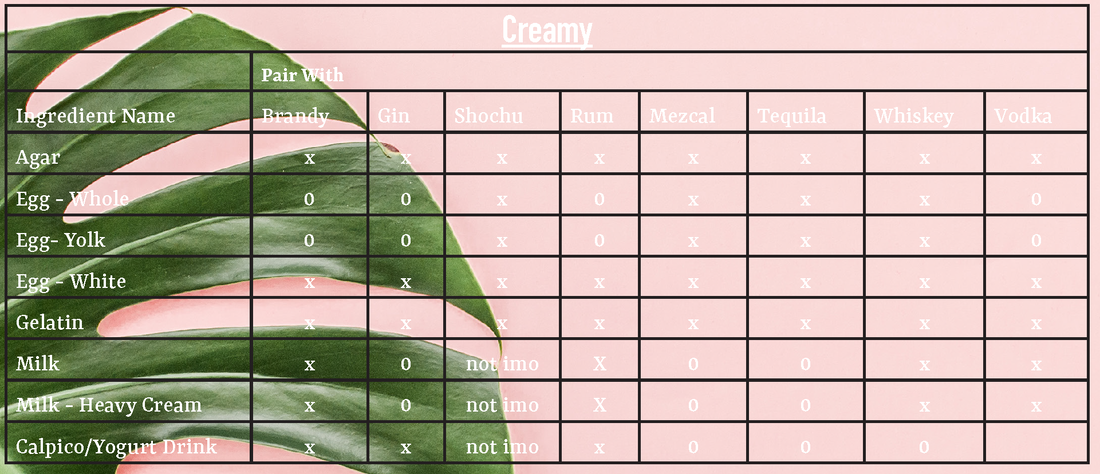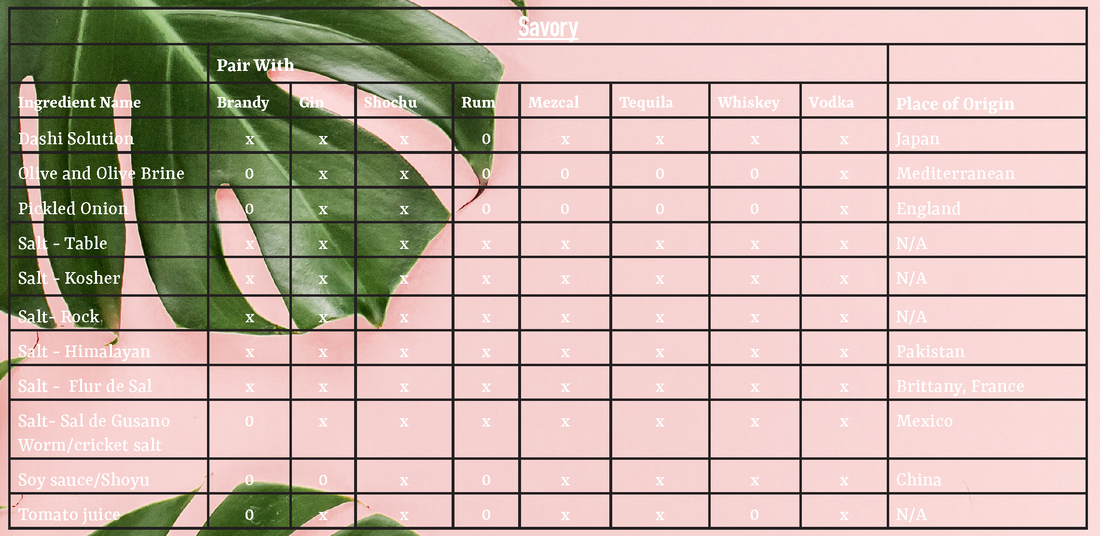A Guide to Cocktail Construction
By; Brent Nakano
Cocktail recipes are generally formulaic. All tend to be derivatives of: Cocktail = Base Spirit + Sweetener + Aromatic Component. Thus, there are a few general cocktail concepts, with the remainder being a variation on the theme in one way or another. However, the way one looks at the core formulas can vary. Staples of every cocktail book collection should include The Cocktail Codex by Alex Day, Nick Fauchald, and David Kaplan of Death and Co., and its predecessor The Joy of Mixology by Gary Regan. These books present their take on the variations with numerous examples. The following is Hawaii Beverage Guide’s simplified take on the core cocktail formulas, and common variations to those core formulas.
Approach to Variations
Base Spirit
Base spirit is a loose term that refers to the predominant flavor of a drink, and there is typically 1.5 to 2 oz of base spirit per cocktail. The base spirit does not have to be a distilled spirit, and can also be a beer or wine. A variation to a base spirit is blending together more than one spirit in a technique known as a “split base”. Similar in concept to what a master blender does at the distillery, utilization of a split base is done to: Add complexity to a more interesting spirit while using a similar but cheaper spirit. This is seen when a bourbon distillery uses some 7 year old product in a bottle listed as 4 years old (age statement is the youngest product). In a cocktail, it is seen when using a Unaged Rum + Aged Rum. Combine different but complementary core flavors. In a distillery, it is akin to blending rye whiskey with malt whiskey, which are different products made from different ingredients. In a cocktail, popular combinations include: Rum + Brandy or Whiskey + Brandy.
Liqueur
Liqueurs ≈ Spirit + Sugar + Fruit and/or herbs
This means that liqueur can be substituted for fruit and sugar, and increasing the base spirit can substitute the missing spirit.
Bitters/Spice (Aromatic Component)
Bitters are at their core, a bittering agent plus aromatic herbs and spices (more information at hawaiibevguide.com/bitters). There are a few options to replace bitters:
Sugar/Sweetener
Sugar can be thought of as shorthand for sweetener. It is one of the easiest ways to add complexity or variation to a cocktail, as sweetness can come from a multitude of ingredients. For example:
Sour Mix
Shorthand for Acid Element + Sugar, sour mix is another highly flexible component in cocktails. This can be manipulated by:
Soda Water/Carbonated Mixer
Soda water can be replaced with a flavored soda, or it can be replaced by another carbonated beverage like sparkling wine. It should be noted that tonic and soda water are not interchangeable.
- To state the obvious: It is important to coordinate flavors that pair well together, as not all spirits work with all ingredients. Similarly, not all flavors work well together. For more on flavor pairing, we highly recommend the Flavor Bible and the Vegetarian Flavor Bible, both by Karen Page and Andrew Dornenburg. We suggest purchasing the digital version for pocket-sized access on your mobile device.
- Whenever modifying or replacing ingredients, proportions may need to be adjusted.
Base Spirit
Base spirit is a loose term that refers to the predominant flavor of a drink, and there is typically 1.5 to 2 oz of base spirit per cocktail. The base spirit does not have to be a distilled spirit, and can also be a beer or wine. A variation to a base spirit is blending together more than one spirit in a technique known as a “split base”. Similar in concept to what a master blender does at the distillery, utilization of a split base is done to: Add complexity to a more interesting spirit while using a similar but cheaper spirit. This is seen when a bourbon distillery uses some 7 year old product in a bottle listed as 4 years old (age statement is the youngest product). In a cocktail, it is seen when using a Unaged Rum + Aged Rum. Combine different but complementary core flavors. In a distillery, it is akin to blending rye whiskey with malt whiskey, which are different products made from different ingredients. In a cocktail, popular combinations include: Rum + Brandy or Whiskey + Brandy.
Liqueur
Liqueurs ≈ Spirit + Sugar + Fruit and/or herbs
This means that liqueur can be substituted for fruit and sugar, and increasing the base spirit can substitute the missing spirit.
Bitters/Spice (Aromatic Component)
Bitters are at their core, a bittering agent plus aromatic herbs and spices (more information at hawaiibevguide.com/bitters). There are a few options to replace bitters:
- Cocktail bitters like Angostura can be swapped for potable bitters, also known as amaro. It is important to note that bitters come in a wide variety of flavors therefor are not completely interchangeable.
- Vermouth, a fortified wine with a bitter component, can also be used instead of bitters.
Sugar/Sweetener
Sugar can be thought of as shorthand for sweetener. It is one of the easiest ways to add complexity or variation to a cocktail, as sweetness can come from a multitude of ingredients. For example:
- Using syrups (flavored and unflavored), liqueurs, or fortified wines instead of sugar adds a sweetening component while also contributing their flavor profile.
- Sour Mix can replace a sweetener
- Fruit is an alternative to sugar as a source of sucrose
Sour Mix
Shorthand for Acid Element + Sugar, sour mix is another highly flexible component in cocktails. This can be manipulated by:
- Changing the citrus. Citrus creates sour notes by contributing citric acid.
- Using a different acid. For example acetic acid (vinegar), malic acid (apples), tartaric acid (grapes), lactic acid (yogurt) can be used.
- Manipulation of sweetener as seen above.
Soda Water/Carbonated Mixer
Soda water can be replaced with a flavored soda, or it can be replaced by another carbonated beverage like sparkling wine. It should be noted that tonic and soda water are not interchangeable.
Additional Ingredients
The following types of ingredients accent a cocktail rather than change its core concept (and thus its category). This is similar to cooking, when a small portion of vegetables and hot sauce added to a dish does not typically mean the dish is now called something else.
- Fresh Herbs (Aromatic Component) In refreshing cocktails, mint is the classic fresh herb. It’s popularity is closely followed by basil, however rosemary, thyme, and sage are also great alternatives. All fresh herbs can be muddled directly into the cocktail to add a pop of aromatic freshness. Another option is a herbal liqueur.
- Spice: Spices can be added to most cocktail styles either by using bitters, integrating them into a syrup like orgeat or grenadine, or the addition of a spice driven liqueur.
- Fruit: Sweet, non-citrus fruit which is freshly muddled into a cocktail can add:
- Sucrose (sugar)
- Aromatic accents
- Using fruit syrups, by nature of a syrup being fruit + sugar, add more sugar but less acidity.
- Salt: Adding salt in the form of a salted rim or saline solution can enhance sweet and sour notes and suppress bitter notes. The quantity of salt added matters, as a light touch will not make the cocktail savory, and a heavy dosage can make a light and refreshing cocktail into a savory cocktail.
Cocktail Ice
Cocktail Ice
Ice controls the dilution of a cocktail. In particular, craft cocktail ice is ideal because it does not contain air pockets that cause ice to melt faster. This means that the cocktail remains chilled without becoming watery.
Typical ice shapes and sizes are:
For more insight into the multitude of variations on craft cocktail ice and how to make it visit Camper English’s Alcademics blog: https://www.alcademics.com/index-of-ice-experiments-on-alcademics.html
Ice controls the dilution of a cocktail. In particular, craft cocktail ice is ideal because it does not contain air pockets that cause ice to melt faster. This means that the cocktail remains chilled without becoming watery.
Typical ice shapes and sizes are:
- Crushed Ice increases dilution of the drink. In a Mint Julep for example, the crushed ice makes the cocktail fairly light and refreshing for being predominantly made of bourbon.
- 1” x 1” cubes from a Kold Draft or Hoshizaki craft ice machine.
- 2” x 2” cubes are typically cut from a block of ice, however Hoshizaki and Kold Draft now have machines that make 2” cubes.
- Collins Ice Spears are cut to be the length of the tall Collins or Highball glass. For example 1.5” x 1.5” x 5”. These are typically cut from a block of Ice or manually frozen in trays for Collins Ice.
- Sphere ice has less surface area than cubes of a similar size.
- Custom shapes like diamonds are used because they look more interesting than cubes.
For more insight into the multitude of variations on craft cocktail ice and how to make it visit Camper English’s Alcademics blog: https://www.alcademics.com/index-of-ice-experiments-on-alcademics.html
Shaking versus Stirring
- Stirring helps chill a drink without making it cloudy due to air bubbles.
- Shaking a drink increases dilution, better chills down a drink, and can better mix ingredients together.
Glassware
|
There is a multitude of specialized glassware, each for a specific type of cocktail. However, it is not economical for many establishments to have two glasses of the same volume, and almost but not exactly, the same shape. Additionally:
Stemware: Coupe vs Martini Glass vs Nick and Nora Glass:
|
Tall Cylindrical Glasses: Highball Glass vs Collins Glass
Short Cylindrical Glasses: Old Fashioned Glass vs Rocks Glass:
|
Cocktail: Base Spirit + Sweetener + Aromatic Component
Notes on Cocktail formulas:
- Classic Examples are cocktails considered “Classic Cocktails.”
- Substyles are cocktails that require more specific ingredients than the overall style, and have many common variations that are considered “classic cocktails”.
- Cocktail Feel is how boozy and spirit forward or light a cocktail is. This generally breaks down to: Spirit Forward, Light Refreshing, Creamy and Savory. When creating a cocktail for a guest, this is one of the key questions asked.
|
Martini
Base Spirit + Aromatized Wine/Fortified Wine
Variations Vermouth/Fortified Wine Vermouth or fortified wine can be swapped with wine. Depending on the flavor profile you are trying to achieve. Another way to think about the utilization of both is:
Martini Substyle Negroni = Base Spirit + Amaro + Vermouth
Duo (Category Name from Joy of Mixology by Gary Regan) Base Spirit + Liqueur
Variations This cocktail style is spirit forward, however can become light and refreshing if the liqueur variation of using fresh fruit and sugar is utilized. Duo Substyle Sangaree (not to be confused with Sangria) Wine + Sugar + Grated Nutmeg
|
Old Fashioned
Base Spirit + Sugar + Bitters
Variations Most Old Fashioned variations revolve around the base spirit and the type of bitters. Old Fashioned Substyle Champagne Cocktail: Sparkling Wine + Sugar + Bitters
Variations:
|
Light and Refreshing Cocktails
|
Julep
Base Spirit + Sugar + Herb
Variations
|
Julep Substyles
Smash = Base Spirit + mint + sugar + fruit
Mulled Wine = Wine (waremed) + sugar + herbs and spices
|
(Effervescent Cocktails)
|
Highball
Base Spirit + Soda Water
Highball Substyle Spritzer = White Wine + Carbonated Beverage
Shandy = Beer + Ginger ale or Ginger Beer
Ricky = Gin or Bourbon + Lemon or Lime + soda *Not a sour because typically no sugar is added
|
Collins
Base Spirit + Citrus + Sugar + Soda Or Collins = Highball + Sour Mix.
In a high volume bar, Lemon Lime Soda can be used to “cheat” the Sugar+Soda. However do not skip the fresh citrus as the acidity is crucial. Sub-Styles Buck = Base Spirit + Ginger Beer/Ginger Ale + Lemon or Lime Juice
Fizz = Base Spirit + Citrus + sugar + Carbonated mixer
Cooler = Wine + Fruit Juice + Soda + Sugar
|
(Sour Variations)
|
Sours
Base Spirit + Sour Mix (Citrus + Sweetener + Foaming Agent)
|
Sour Substyles
Cobbler = Spirit + sugar + fruit (not citrus) + Crushed ice
Fix = Base Spirit + Lemon Juice + Sugar + other sweet fruit
Colada = Base Spirit + Acetic Fruit juice typically pineapple + Creme de Coconut
|
Swizzle = Rum + Lime Juice + Bitters
Rum coolers from the West Indies made in tall glasses with ice, swizzled with a branch of the Quararibea turbinata until the glass became frosted
Shrub = Base Spirit + shrub (Shrub = vinegar + sugar + fruit)
|
International Sours
|
Base Spirit + Citrus + Liqueur
Category name from Joy of Mixology by Gary Regan
Variations International Sours provide ample opportunity for variation due to its complex ingredient list.
|
International Sour Substyles
Crusta = Base Spirit + Lemon Juice + Bitters + Sugar Crusted Rum + Long Lemon Peel Garnish
Daisy = Base Spirit + orange liqueur + Lemon or Lime juice
|
Fruit Cup = Base Spirit + Vermouth + Liqueur + Bitters + Soda + fruits and herbs as garnish
*Can also be classified as a punch
Sangria = Red Wine + Spirit + Fruit (for acid) + Sweetener
|
|
Punch
Base Spirit + Sour mix + Spice
Variations Beyond variations in citrus, variations in the spice combinations in syrups like orgeat and falernum are common. |
Punch Substyles
Tiki Drinks: Base Spirit (Typically rum) + Tropical or Citrus Fruit Juice + Liqueur + Sweetener (Syrup including gomme syrup)
|
Grog = Rum + lemon juice + sugar/sweetener + Spice + Water
|
|
Creamy Cocktails
Flip Aged Base Spirit + Creamy Ingredient (whole egg or cream) + Sugar
Variations
Flip Substyles Nogg = Base Spirit (Rum, Brandy, Bourbon) + Cream/Milk + Sugar + Egg Yolk
|
Tomato Based Cocktails
Bloodies Base Spirit + Tomato Juice + Worcestershire
A Note on Nightclub Cocktails Even the drinks at high volume establishments which are not classic cocktails or craft cocktails typically fall into two categories:
|
Cocktail Ingredients
There are a multitude of non-alcoholic ingredients that can be used in cocktails. Often, these flavors are familiar and easier to understand than the complex flavors of spirits, liqueurs, fortified wines and amaros. For this reason, we typically recommend those getting into mixology start by using a base spirit, and then fresh ingredients that they understand.
Ingredient Form Factors
Ingredient Tables:
The following are a list of culinary ingredients that can be found in bars and integrated into cocktails. These are intended as quick reference tables and as a checklist for doing cocktail development so that you don't miss ingredients that you're familiar with and just forgot to think about. They are not intended to be memorized, however many probably already have built flavor recall for all of these products and have their own opinion on what pairs with what spirits. We have also included the place of origin for the ingredients so that when doing menu development, there is a quick reference for those interested in telling a cultural story. On hawaiibevgudie.com there will be additional usage suggestions. We will also be updating the table periodically with an emphasis of building more accurate spirit pairings.
Ingredient Table Legend
x = pairs with 0 = does not pair with not imo = does not pair with imo shochu aged = only pairs with aged version of spirit
Ingredient Form Factors
- Fresh ingredients are ideal for the same reason fresh (rather than frozen or canned) ingredients are used in the kitchen. That is, they taste more dynamic and lively. It should be noted not all ingredients can be used fresh because they may not be able to integrate into cocktails due to their form factor. Bananas for example are very starchy, and outside of blending, require processing.
- Frozen ingredients can be cost effective, and if the ingredients are muddled, they may not matter much.
- Juiced ingredients are typically more cost effective than fresh, but vary in quality. Orange juice from concentrate is not as tasty as commercially available orange juice “not from concentrate”.
- Fruit preserves, like jams and jellies can be used to add fruit as well as add sugar to a drink.
Ingredient Tables:
The following are a list of culinary ingredients that can be found in bars and integrated into cocktails. These are intended as quick reference tables and as a checklist for doing cocktail development so that you don't miss ingredients that you're familiar with and just forgot to think about. They are not intended to be memorized, however many probably already have built flavor recall for all of these products and have their own opinion on what pairs with what spirits. We have also included the place of origin for the ingredients so that when doing menu development, there is a quick reference for those interested in telling a cultural story. On hawaiibevgudie.com there will be additional usage suggestions. We will also be updating the table periodically with an emphasis of building more accurate spirit pairings.
Ingredient Table Legend
x = pairs with 0 = does not pair with not imo = does not pair with imo shochu aged = only pairs with aged version of spirit
Usage Approach:
- When using citrus juice, it is crucial to recognize that each fruit has its own unique flavor and ripeness. This means the proportion of sugar may need to be adjusted to reach the desired end flavor.
- Citrus oils can impart a flavor essence without the citric acid brightness. These oils can be expressed by squeezing them over the top, flaming them with a match (lighter fluid can influence the taste), rubbing them on the rum of the glass, or muddling them into the drink.
- When muddling citrus in a drink, the pith can provide bitterness due to its concentration of tannins, in particular the phenol compound naringin. This can be good as it can tone back sweetness, or bad if you’re trying to keep a clean flavor profile.
- Citrus that is approximately 4 hours old is preferred over fresh pressed citrus. The result was found in a tasting panel conducted by cocktail author, and Booker and Dax owner Dave Arnold. His perspective can be found here: http://cookingissues.com/2010/10/01/fresh-lime-juice-wtf/
- Pineapple and other fruits that are high in citric acid, though not citrus fruits, can be used in a similar way.
Fruit (non-citrus) Usage Approach
• The usage of tropical fruit will vary by the fruit, however for the most part they can be muddled into drinks, or will come in the form of a juice.
• In Hawaii, tropical fruit provides ample opportunity to connect people with local produce and fresh flavor profiles that do not exist in many other places in the world.
• The usage of tropical fruit will vary by the fruit, however for the most part they can be muddled into drinks, or will come in the form of a juice.
• In Hawaii, tropical fruit provides ample opportunity to connect people with local produce and fresh flavor profiles that do not exist in many other places in the world.
Usage Notes
Herbs can be used to provide fresh aromatic notes. Herbs, combined with citrus can be particularly helpful when trying to keep a drink from being syrupy, cough medicine or artificial tasting.
Herbs can be used to provide fresh aromatic notes. Herbs, combined with citrus can be particularly helpful when trying to keep a drink from being syrupy, cough medicine or artificial tasting.
|
There are two major styles of tea:
• Tea from the leaves of the Camellia sinensis plant. This includes in order of oxidization, green tea, white tea, oolong tea, and black tea. • Herbal “tea” which does not come from tea leaves but are rather a mixture of flowers, herbs and spices. |
Tea Usage Notes
• Tea gives a highly aromatic complexity to a cocktail. • Lapsang Souchong adds a smoky flavor as it is smoked Camellia sinensis |

